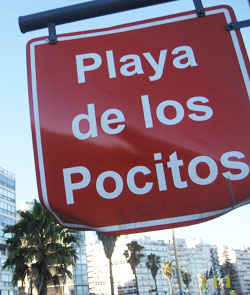Join the UruguayNow mailing list:
UruguayNow in the press
UruguayNow's mix of travel and tourist information on Uruguay, hotel reviews for Montevideo and Punta del Este (coming soon for Colonia), restaurant reviews and tips on excursions, sightseeing and lifestyle in Uruguay has been featured in El Pais, La Republica, MercoPress and on Uruguay's Channel 5 TV and other news media in the country. Internationally, we have had kind mentions in the New York Times and the Daily Telegraph.
Best of the Web
Not yet made it to Uruguay? When you're done with UruguayNow, our choice of the top 6 internet resources for the country is just a mouse click away. In no particular order, they are:
Southern Cone Travel: http://southernconeguidebooks.blogspot.com/
Mercopress: http://en.mercopress.com/
Ola Uruguay: www.olauruguay.com
Retired in Uruguay: http://wallyinuruguay.blogspot.com/
Uruguay Natural: www.uruguaynatural.com
Global Property Guide: http://www.globalpropertyguide.com/Latin-America/Uruguay
For reviews of these sites, please click here.
Other recommended sites

Parque Rodó, Pocitos & Punta Carretas
One of the city’s nicest parks is the Parque Rodó, in the genteel but shabby residential district of the same name. This is the area just above Ramírez beach, where the people of Montevideo started to enjoy days out at the seaside. It's the closest stretch of sand to downtown. The graceful former hotel building standing on the Rambla (promenade) at the edge of the park now houses the administrative headquarters of the Mercosur trade bloc.
Full of palms, eucalyptus and the native omb� tree, Parque Rodó was conceived as a traditional French-style city park. It’s at its most lively on Sundays, but don’t forget mosquito repellant if you visit in the summer months. Find time, too, to visit the National Museum of Visual Arts nearby, for the city’s best overview of Uruguayan painting. There are some Southern School artists (Joaquin Torres García, Jose Gurvich) represented here, but it really excels in its permanent collection of works by painters such as Pedro Figari, whose sympathetic portraits of carnival dancers and country life are a highlight. The quiet streets (look out for some wonderfully ornate wooden doors) of Parque Rodó run seamlessly into the Palermo neighbourhood. This is the venue for Sunday night drumming sessions, a little bit of Carnival year-round (see our feature).
A city with a central golf course? Yes, you’d better believe it. The 18-hole course, designed by a Scotsman, is on the left hand-side of Bulevar Artigas as you walk up the artery, with Punta Carretas on your right. If you’re not a member, or invited by one, you’ll only get past the security guards on Sundays between 2pm and 6 pm if you ask to be admitted for a stroll.
Punta Carretas used to be the location for the city’s main prison, which gained notoriety due to the massive incarceration of dissidents during the twelve years of military dictatorship which started in 1973. During this period, one in every 50 Uruguayans was arrested at some point for supposed subversive activities and one in 500 was jailed for terms of six years or more: one of these was Uruguay’s new president, José "Pepe" Mujica.
The prison is no more: it has become a huge shopping centre (McDonald's occupies one of the original administration buildings). Just behind it, the sleek new Sheraton hotel dominates the horizon. What used to be a middle-class neighbourhood of pretty yet modest two-storey houses, where everyone knew everyone else, has changed as money poured into the district. Now Punta Carretas is the city’s most exciting dining quarter: our choice of best restaurant in Montevideo, Francis, is located here.
The beach suburbs stretching east of the lighthouse at Punta Carretas are mainly modern, with 10-storey apartment blocks fronting the water the norm. A surprise, then, to stumble on the Juan Zorrilla de San Martín museum, the summer house (built between 1910 and 1922) of the Uruguayan poet of the same name. The museum contains some of the poet’s personal belongings, but the most pleasant aspect is the beautiful formal garden with its wealth of original tiles. Note that there is no café in the museum or anywhere to buy drinks or water.
Adjacent to Punta Carretas, the wealthy neighbourhood of Pocitos has a popular crescent-shaped beach with water theoretically clean enough for swimming. Many more people, however, use the Rambla to jog, stroll, people-watch or eat ice cream. Early in the morning teams of dog walkers can be seen with their charges. It can be difficult for visitors to get a handle on Pocitos. We suggest that you take a walk up Cavia street to see something of the “old" Pocitos: graceful old mansions alternate with apartment blocks amid exuberant greenery. The ivory-white Italian embassy, perhaps the most sumptuous residence in the district, is a short walk left on Ellauri street. When you reach the junction of Cavia and Libertad streets, turn right and walk as far as Avenida Brasil. Walking down Avenida Brasil towards the shore, you’ll see another beautiful mansion opposite the Bar Valerio, complete with stained glass windows and ornate flourishes on its outside columns. The building is now used as a women’s arts and dance centre.
